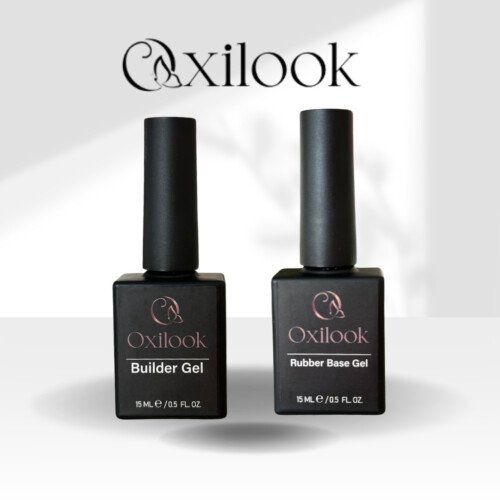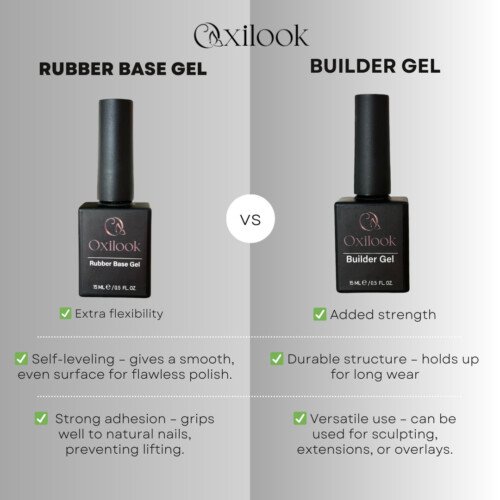Nail Supply
Rubber Base Gel vs. Builder Gel: Which One Should You Choose?
Gel enhancements now account for the majority of salon nail services. If you’re weighing the difference between rubber base gel and builder gel you’re in good company. Both formulas promise durable wear and flexible strength. Each excels in different applications. Good news, once you pick the right gel you’ll see smoother application and happy clients. Your choice boils down to support versus structure. Use rubber base gel under polish and builder gel when you want sculpted shape or length.
Understand rubber base gel
What is rubber base gel?
A rubber base gel is a soak-off gel polish formula designed as a flexible base coat. It blends elastic polymers and adhesion promoters to create a tacky layer that grips your natural nails. Many brands market it as a ‘soft gel base’ for under-color strength. You can learn more in our guide to what is rubber base gel.
An example is OPI’s GELement™ Base & Top Coat. It grips color and resists scratches for long-lasting shine (OPI).
Key benefits and drawbacks
- Pro: provides a thin, elastic base that reduces lift and chipping. Con: limited thickness means less support for length.
- Pro: soaks off easily, usually in about 10 minutes. Con: needs multiple thin layers to build strength.
- Pro: pairs well with gel polish and color coats. Con: does not sculpt or repair significant breaks.
Ideal uses for rubber base gel
- Under gel polish to improve adhesion
- As a strengthener for thin or peeling nails
- To correct minor ridges or surface imperfections
- In clients who prefer a natural nail overlay
You might find yourself reaching for rubber base gel whenever a client wants a natural-looking boost.
Explore builder gel
What is builder gel?
Builder gel, sometimes called structure gel, is a thicker soak-off gel designed for building nail extensions and repairs. Its high viscosity lets you sculpt tips or create an overlay without forms or tips. Read more in our article on what is builder gel.
Brands like Luminary Nail Systems offer blends that mimic acrylic toughness while maintaining gel flexibility, such as their Premium Flex-Gel X (Luminary Nail Systems).
Key benefits and drawbacks
- Pro: builds structure and length with one product. Con: higher viscosity can be tricky for beginners.
- Pro: strong finish that resists chips and cracks. Con: longer soak-off time, up to 15 minutes.
- Pro: ideal for fills, repairs, and custom shapes. Con: may require more nail prep to ensure adhesion.
Ideal uses for builder gel
- Sculpting free-edge extensions with forms or tips
- Repairing breaks and filling cracks
- Overlaying tips for added thickness and durability
- Creating custom 3D nail art shapes
You’ll love builder gel for any time you want solid structure and minimal layers.
Compare performance factors
Strength and adhesion
| Characteristic | Rubber base gel | Builder gel |
|---|---|---|
| Viscosity | Medium for thin coats | Thick for sculpting |
| Structural support | Moderate under polish | High structure and reinforcement |
| Flexibility | High, reduces breakage | Medium, more rigid after cure |
| Soak-off removal | 10 minutes | 15–20 minutes |
Finish and flexibility
Rubber base cures with a slightly chewy layer that tacks under color and stays flexible. Builder gel cures to a firm finish that you may need to buff or file to remove tack. Both offer a glossy look once topped with a clear gel topcoat.
Application and curing
For rubber base, apply one thin coat and cure under LED for 30 seconds (or UV for 2 minutes). Repeat for extra strength. With builder gel, layer medium beads, shape with a brush, and cure for 60 seconds under LED (or 2 minutes under UV). Build shape gradually to avoid uneven edges.
Choose the right gel
When to use rubber base gel
- As a base under gel polish for better adhesion
- When a client wants a natural-feeling overlay
- For repeat clients needing gentle strengthening
- If quick soak-off removal is a priority
When to use builder gel
- Building extensions or free-edge length
- Repairing a cracked nail or break
- Creating custom nail shapes or 3D art
- When clients demand maximum durability
Quick recap and next step
Now that you know how rubber base gel and builder gel differ, pick one to test in your next service. Keep both formulas on hand: apply rubber base under color, and switch to builder gel for sculpted sets. You’ve got this—your clients will thank you for nails that last longer and look flawless.
Frequently asked questions
- What is the main difference between rubber base gel and builder gel?
The core difference lies in viscosity and intended use: rubber base gel is thinner for a flexible foundation under polish, while builder gel is thicker to build and sculpt nail enhancements. Learn more in rubber base gel vs builder gel. - Is builder gel the same as rubber base?
No, builder gel has a higher viscosity and is formulated for structure and length, whereas rubber base is lighter for use as a base coat. Find out in is builder gel the same as rubber base?. - Can I use builder gel on natural nails?
Yes, you can apply builder gel directly on natural nails to add strength and minor length with one formula. See guidelines in can i use builder gel on natural nails. - Does a rubber base need UV light?
Yes, rubber base gels cure under UV or LED lamps, typically in 30–60 seconds. Learn more at does a rubber base need uv light. - Can I use builder gel as a base coat?
While builder gel can act as a base in a pinch, it is thicker and harder to work with than a dedicated base coat. Check tips in can i use builder gel as base coat.


